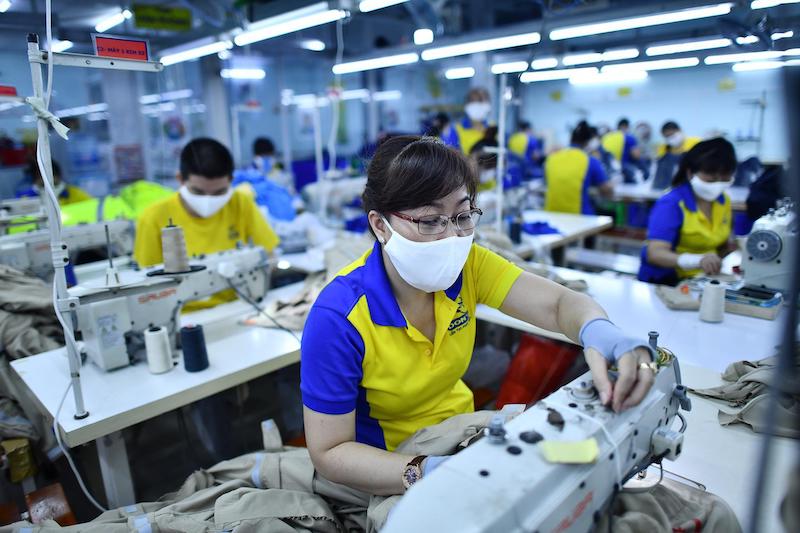Promoting the greening of the textile industry
Welcoming investment waves enables Vietnamese enterprises to access modern technology and projects that support green transformation, helping businesses meet standards and enhance competitiveness.
According to Deputy Minister of Industry and Trade Phan Thi Thang, the Vietnamese textile industry has made strong progress in recent years and has increasingly played a significant role in the country's economic growth.

Positive Signals
Textiles are one of the primary export industries that play an important part in economic growth, accounting for 12-16% of the country's overall export turnover.
According to Deputy Minister Phan Thi Thang, Vietnamese textile export turnover has expanded approximately sixfold in the more than 15 years since entering the World Trade Organization (WTO). Furthermore, the textile sector today employs over 2 million industrial workers, accounting for more than 10% of the country's total industrial labor force. "As a result, the textile sector not only contributes to the country's third-largest export turnover but also to societal stability," highlighted Deputy Minister Phan Thi Thang.
Textile exports totaled 40.3 billion USD in 2023, a 9.2% decline from 2022. However, one of the textile industry's highlights last year was its market penetration. In addition to traditional markets such as the United States, Japan, South Korea, and the European Union, Vietnam has exported substantial amounts of textiles to Canada, China, the United Kingdom, Australia, Russia, Indonesia, Thailand, Hong Kong (China), India, and so on.
In 2024, the textile market showed positive signs compared to 2023. As of February 15, 2024, Vietnamese textile exports were 4.9 billion USD (a 17% increase over the same time in 2023). Factory activities have resumed for the new year, with a large number of people returning to work.
However, with geopolitical and international trade fluctuations, high inventory levels, and a severe decline in general goods demand, particularly for textile products, combined with rising raw material costs, Vietnamese textile enterprises are having difficulty finding and maintaining markets and sourcing raw materials.
Leveraging FTAs
To overcome these challenges, the Deputy Minister suggests that Vietnamese textile enterprises deepen their development, actively seek and participate in the global textile supply chain, focusing on high value-added processes such as design, production of raw and auxiliary materials, particularly fabrics, and distribution system development, gradually moving up the production chain.

Vietnam currently attracts large textile brand enterprises from the UK, Germany, Italy, the USA, Switzerland, Japan, South Korea, Hong Kong, Taiwan, China.
Aside from local firms, Vietnam now draws significant textile brand enterprises from the United Kingdom, Germany, Italy, the United States, Switzerland, Japan, South Korea, Hong Kong, Taiwan, and China.
Vietnam is considered an attractive destination for textile investors across the entire value chain, including fiber enterprises, technology, dyeing, finished fabrics, design, and garment manufacturing, with major textile brand enterprises from the United Kingdom, Germany, Italy, the United States, Switzerland, Japan, South Korea, Hong Kong, Taiwan, and China.
"Moreover, being a member of international trade agreements such as the Regional Comprehensive Economic Partnership (RCEP), the Comprehensive and Progressive Agreement for Trans-Pacific Partnership (CPTPP), and the EU-Vietnam Free Trade Agreement (EVFTA)... continues to signal even more positive development for the textile industry," assessed Mr. Detlef Braun, Member of the Executive Board of Messe Frankfurt Group, Germany.
In actuality, compared to the challenging circumstances in 2023, the order situation for textile firms in the early months of 2024 has improved, with many enterprises holding orders till the end of June or even the end of the year. The textile sector expects to attain an export turnover of 44 billion USD in 2024, a 9% increase over 2023.
Experts say that as the market warms up, many retail organizations in FTA member nations like Canada and Europe are looking to Vietnam for competitive supply chains. To deliver complete textile goods, businesses must fully capitalize on possibilities provided by free trade agreements (FTAs) and engage in supply chains.
In addition, leverage possibilities from FTAs in labor utilization, input materials, and sustainable development in exports; proactively arrange equipment conditions, management capabilities, and production with the best productivity and quality to welcome fresh "waves" of orders. Furthermore, businesses must improve their competitiveness, focus on brand development, and fulfill sustainability criteria.
The Ministry of Industry and Trade presented Decision No. 1643/QĐ-TTg to the Prime Minister on December 29, 2022, to approve the Strategy for the Development of the Textile and Footwear Industry until 2030. Exports remain the primary driver of development and growth in the textile industry, diversifying export markets while maximizing domestic market development; improving the domestication rate, increasing the added value of Vietnamese fashion textile products; and developing the textile industry in tandem with environmental protection.
"The textile sector will also have access to current and sophisticated technology from the EU, as well as attract investment and support initiatives that encourage green production transformation, allowing Vietnamese goods to satisfy EU requirements. As a result, the new generation free trade agreements' rules of origin criteria are met, the added value of products is increased, and the Vietnamese textile industry's growth towards green and sustainable trends is promoted globally," Deputy Minister Phan Thi Thang noted.








